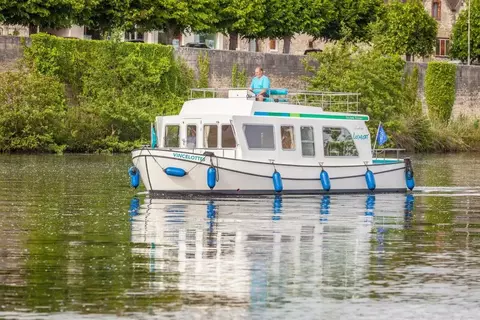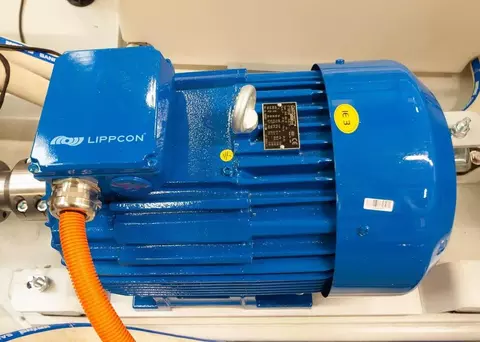ATTENTION
Due to Whitsun we are closed on Monday 20th May
Linssen and electric or hybrid drive


Linssen Pénichette with LIPPCON® propulsion system for Locaboat
We developed the brand new Linssen Pénichette Évolution for Locaboat, one of the biggest players in the charter industry. This prototype is equipped with the LIPPCON® propulsion system. At the heart of the LIPPCON® system is a silent diesel generator. This provides power for the main electric motor that drives the propeller shaft and a separate electric motor that drives the bow thruster and stern thruster. It also powers all the electrical equipment on board, even when the main engine is not running. The boat also has a joystick steering system that makes it easy for any beginner or indeed any expert to manoeuvre the boat, with LIPPCON® determining the interaction between the main engine, bow and stern thruster, all through the use of electric motors.
That’s LIPPCON® as well!
Locaboat has put 38 Pénichettes into service since July 2017. This is an excellent opportunity for us to put our electric drive technology to the test on a large scale and in a real-life situation. Initial results are promising.
The world of propulsion systems has been turned on its head in recent years. Since the political agenda both nationally and internationally is partly determined by the Green Deal - with the goal of halving carbon emissions by 2030 - numerous sectors are working on this theme. Unlike manufacturers in the automotive sector, a relatively small sector like yacht building does not yet have any specific obligations in this area. However, since we share some of our technology with this sector, this issue is getting closer within our industry as well.
Passenger car versus truck, sports boat versus motor yacht
Although motor yachts are regularly compared to passenger cars, this applies only to small open boats of less than 10 metres. Once yachts become larger and heavier, a comparison with a truck or coach is more appropriate. The weight, power requirements and nature of use (long trips) are more in line with these vehicles. The still limited charging infrastructure is also similar to our industry. Autonomy is highly important.
However, trucks, coaches and our motor yachts also have a lot of mass, and all this mass has to be set in motion and kept moving. This takes a lot of power.
If we multiply the desired autonomy by the required power, we soon see that this leads to a large battery capacity. And batteries are still very expensive. This is also why today we see almost only hybrid solutions: a diesel engine (generator) - no less powerful than usual - supplemented by an additional electric drive with a small battery pack. This is obviously a nice solution, but does it deliver? In fact, they are two separate drives on the same propeller. However, the price is significantly increased by this dual drive, as are the maintenance costs, while there is hardly any positive effect on the environment. Thus, it is not a real solution that contributes to carbon reduction. This is only possible with 100% electric power and then only when the energy is generated responsibly.
At Linssen Yachts, we are specifically working on this subject, but with a focus on 100% electric power. Of course we are also following developments in other areas, such as hydrogen, but this technology may still have a longer way to go than battery power.
Linssen yachts with 100% electric drive?
Back to electric drive. To bring a motor yacht up to cruising speed, a power output of 3 to 4 kW per tonne is required. A steel 35-foot motor yacht weighing 8 to 9 tonnes requires a power output of about 25-30 kW per sailing hour. So you need a 100-150 kW battery pack to sail for a day. This doesn’t even take into account the power consumed by the on-board power supply, the bow and stern thruster and the heating. Due to the huge demand for batteries and their relatively limited production capacity, prices are currently still very high, generally around EUR 1,000 per kWh. Anyone who can do a quick calculation will see that the basic battery pack alone will cost a huge amount.
If you then compare that to the low pollution of our diesel engines chosen exactly for hull speed, the current drive is still definitely the least polluting!
Charging
We do believe in the potential of this technology, even for our industry, but it needs time to develop further until all the critical factors are favourable enough to make it practically and economically viable. The energy density, the number of charging cycles and the lifetime of batteries are improving all the time and the price is gradually falling. Solar systems are becoming increasingly efficient and can help to recharge the batteries (to some extent) while the yacht is in use. A charging infrastructure also has to be developed at marinas. This is a matter for marina owners and perhaps politicians as well. In addition, we will of course be looking at ways of reducing the weight of our motor yachts so that less power is needed - while maintaining quality and sailing characteristics.
It takes time to bring all these factors together. Our research team conducts tests and surveys, and interviews leading authorities to gain knowledge. In this way - when the time is right - we will also be able to add electrically powered yachts to our product range. A highly charged event...
We’ll keep you informed!
